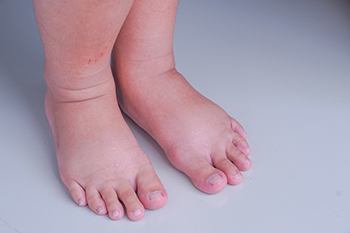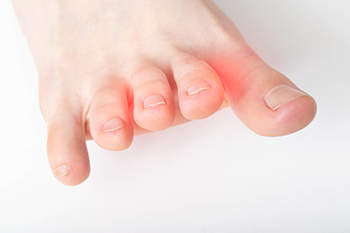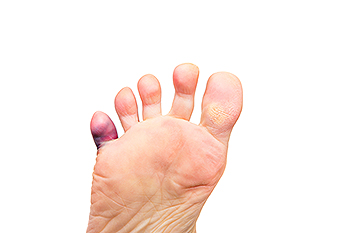Items filtered by date: May 2023
Reasons the Feet Can Become Swollen

Having swollen feet is uncomfortable. There are various reasons why this condition can happen, ranging from pregnancy to eating foods that are laden with sodium. Swollen feet can also be accompanied by skin that is tight, puffy, and shiny, and depending on its severity, may cause difficulty in walking. Additionally, there may be existing medical conditions that can lead to having swollen feet. These can include heart failure, kidney disease, or venous insufficiency. Swollen feet may happen from having a sedentary lifestyle, and it can be helpful to include gentle exercise into the daily routine. Pregnant women may wish to reduce sodium intake and drink plenty of water daily may help to combat swollen feet and ankles. If you have swollen feet, it is suggested that you confer with a podiatrist who can offer additional methods.
Swollen feet can be a sign of an underlying condition. If you have any concerns, contact one of our podiatrists of Palmetto Podiatry Group of Anderson. Our doctors can provide the care you need to keep you pain-free and on your feet.
Swollen feet are a common ailment among pregnant women and people who stand or sit for extended periods. Aging may increase the possibility of swollen feet and patients who are obese often notice when their feet are swelling too. There may be medical reasons why swollen feet occur:
- Phlebitis - A condition that causes the veins to become inflamed and can also cause leg pain.
- Liver disease - This may lead to low blood levels of albumin which is a protein. This can cause fluid in the blood to pass into the tissues and several areas of the body can become swollen.
- Heart failure - When the heart doesn’t pump properly the blood that is normally pumped back to the heart can pool in the veins of the legs causing swollen feet.
- Kidney disease - One of the main functions of the kidneys is releasing excess fluid in the body. This type of condition can make it difficult for the kidneys to function properly, and as a result the feet may become swollen.
- Deep-vein thrombosis (DVT)- This is a serious condition where blood clots form in the veins of the legs. They can block the return of blood from the legs to the heart which may cause the feet to swell. It is important to be treated by a podiatrist if this condition is present.
Swollen feet can also be caused by bone and tendon conditions, including fractures, arthritis, and tendinitis. Additionally, there may be skin and toenail conditions and an infection may cause the feet to swell. Patients who take medicine to treat high blood pressure may be prone to getting swollen feet.
Many patients elevate their feet to help relieve the swelling and this is generally a temporary remedy. When a podiatrist is consulted the reason behind the swelling can be uncovered and subsequently treated.
If you have any questions please feel free to contact our office located in Anderson, SC . We offer the newest diagnostic tools and technology to treat your foot and ankle needs.
High Heels and Morton’s Neuroma

A compressed or irritated growth that is found between the third and fourth toes can represent a foot condition known as Morton’s neuroma. It is considered to be benign, despite how painful it can be. Wearing shoes that do not have enough room for the toes to move freely can be a common cause for this condition to occur. High heels fit into this category, and women who frequently wear this type of shoe may be affected. People who are afflicted with this ailment often feel they have a small pebble in their shoe or sock, typically on the ball of the foot. This part of the foot is used for standing and walking, which can cause constant pain. Patients who notice the beginning signs of Morton’s neuroma may find temporary relief when better shoes are worn. For more severe cases, it is suggested that you consult with a podiatrist who can provide you with permanent relief solutions.
Morton’s neuroma is a very uncomfortable condition to live with. If you think you have Morton’s neuroma, contact one of our podiatrists of Palmetto Podiatry Group of Anderson. Our doctors will attend to all of your foot care needs and answer any of your related questions.
Morton’s Neuroma
Morton's neuroma is a painful foot condition that commonly affects the areas between the second and third or third and fourth toe, although other areas of the foot are also susceptible. Morton’s neuroma is caused by an inflamed nerve in the foot that is being squeezed and aggravated by surrounding bones.
What Increases the Chances of Having Morton’s Neuroma?
- Ill-fitting high heels or shoes that add pressure to the toe or foot
- Jogging, running or any sport that involves constant impact to the foot
- Flat feet, bunions, and any other foot deformities
Morton’s neuroma is a very treatable condition. Orthotics and shoe inserts can often be used to alleviate the pain on the forefront of the feet. In more severe cases, corticosteroids can also be prescribed. In order to figure out the best treatment for your neuroma, it’s recommended to seek the care of a podiatrist who can diagnose your condition and provide different treatment options.
If you have any questions, please feel free to contact our office located in Anderson, SC . We offer the newest diagnostic and treatment technologies for all your foot care needs.
The Importance of Daily Foot Care

The feet can be a barometer of our health, and like other parts of our bodies, it is important to care for our feet. The feet need to be strong, limber, and stable to perform daily functions, keep us upright, and prevent us from falling. Foot pain is common, yet many of us do not care for our feet as we should. A daily foot routine can go a long way in preventing foot problems. Things to consider doing as part of such a routine include washing, drying, and moisturizing the feet daily, cutting toenails regularly and straight across to prevent ingrown toenails, and wearing shoes that are comfortable and fit well. Examining the feet for brewing issues, such as cuts, growths, or discoloration, is also important. If you would like more information on caring for your feet, it is suggested that you make an appointment with a podiatrist today.
Everyday foot care is very important to prevent infection and other foot ailments. If you need your feet checked, contact one of our podiatrists from Palmetto Podiatry Group of Anderson. Our doctors can provide the care you need to keep you pain-free and on your feet.
Everyday Foot Care
Often, people take care of their bodies, face and hair more so than they do for their feet. But the feet are a very important aspect of our bodies, and one that we should pay more attention to. Without our feet, we would not be able to perform most daily tasks.
It is best to check your feet regularly to make sure there are no new bruises or cuts that you may not have noticed before. For dry feet, moisturizer can easily be a remedy and can be applied as often as necessary to the affected areas. Wearing shoes that fit well can also help you maintain good foot health, as well as making it easier to walk and do daily activities without the stress or pain of ill-fitting shoes, high heels, or even flip flops. Wearing clean socks with closed shoes is important to ensure that sweat and bacteria do not accumulate within the shoe. Clean socks help to prevent Athlete’s foot, fungi problems, bad odors, and can absorb sweat.
If you have any questions please feel free to contact our office located in Anderson, SC . We offer the newest diagnostic and treatment technologies for all your foot and ankle needs.
Do Your Child's Feet Hurt?
Pinky Toe Pain

As small as the pinky toe is, it can become extremely painful when it is injured. Pain in this toe may come from a variety of causes including a break or sprain, wearing shoes that are too tight, or a corn. This toe is more prone to injury because it is on the outside of the foot. An injury to this toe may result in swelling and pain. A broken or fractured pinky toe can happen if it is stubbed from a direct blow or a heavy object falls on it. A sprained pinky toe can happen from bumping the toe or stretching it beyond its normal range. It involves injury to the ligament of the toe. A corn, with hardened layers of skin, can develop on the small toe in response to pressure or friction and often from wearing tight-fitting shoes. Since the varied causes of pain in the pinky toe result in similar symptoms, if you have pain in this toe that does not resolve with rest, it is suggested that you visit a podiatrist for a proper diagnosis and treatment. This is important to ensure that it heals properly and does not lead to other problems.
Toe pain can disrupt your daily activities. If you have any concerns, contact one of our podiatrists of Palmetto Podiatry Group of Anderson. Our doctors can provide the care you need to keep you pain-free and on your feet.
What Causes Toe Pain?
Most severe toe pain is caused due to a sports injury, trauma from dropping something heavy on the toe, or bumping into something rigid. Other problems can develop over time for various reasons.
Toe pain can be caused by one or more ailments. The most common include:
- Trauma
- Sports injury
- Wearing shoes that are too tight
- Arthritis
- Gout
- Corns and calluses
- Hammertoe
- Bunions
- Blisters
- Ingrown toenails
- Sprains
- Fractures (broken bones)
- Dislocations
When to See a Podiatrist
- Severe pain
- Persistent pain that lasts more than a week
- Signs of infection
- Continued swelling
- Pain that prevents walking
Diagnosis
In many cases the cause of toe pain is obvious, but in others, a podiatrist may want to use more advanced methods to determine the problem. These can range from simple visual inspections and sensation tests to X-rays and MRI scans. Prior medical history, family medical history, and any recent physical traumatic events will all be taken into consideration for a proper diagnosis.
Treatment
Treatments for toe pain and injuries vary and may include shoe inserts, padding, taping, medicines, injections, and in some cases, surgery. If you believe that you have broken a toe, please see a podiatrist as soon as possible.
If you have any questions please feel free to contact our office located in Anderson, SC . We offer the newest diagnostic tools and technology to treat your foot and ankle needs.
Various Categories of Broken Toes

There are bones in the toes that are known as phalanges. The big toe has two, which are referred to as the distal and the proximal. The remaining toes have three phalanges, and an additional one is found between the distal and proximal. The bones in the toes can be easily fractured, as they are at the end of the body. When an injury happens, and the impact presses the ends of the bone toward the center, this is known as a compressed fracture. If the bone split into many pieces, a comminuted fracture has occurred. A displaced fracture is noticeable as the bone protrudes from the skin, and moves out of alignment. Conversely, a bone that is broken and remains in its normal position is called a non-displaced fracture. Research has shown the most commonly broken toe is the pinky. This can happen if the toe is stubbed into a piece of furniture, or if a heavy object suddenly drops on it. An X-ray is generally performed that can determine the extent of the injury. If you have broken your toe, it is suggested that you confer with a podiatrist who can begin you on the right treatment path.
Broken toes may cause a lot of pain and should be treated as soon as possible. If you have any concerns about your feet, contact one of our podiatrists from Palmetto Podiatry Group of Anderson. Our doctors will treat your foot and ankle needs.
What Is a Broken Toe?
A broken toe occurs when one or more of the toe bones of the foot are broken after an injury. Injuries such as stubbing your toe or dropping a heavy object on it may cause a toe fracture.
Symptoms of a Broken Toe
- Swelling
- Pain (with/without wearing shoes)
- Stiffness
- Nail Injury
Although the injured toe should be monitored daily, it is especially important to have a podiatrist look at your toe if you have severe symptoms. Some of these symptoms include worsening or new pain that is not relieved with medication, sores, redness, or open wounds near the toe.
If you have any questions, please feel free to contact our office located in Anderson, SC . We offer the newest diagnostic and treatment technologies for all your foot care needs.

